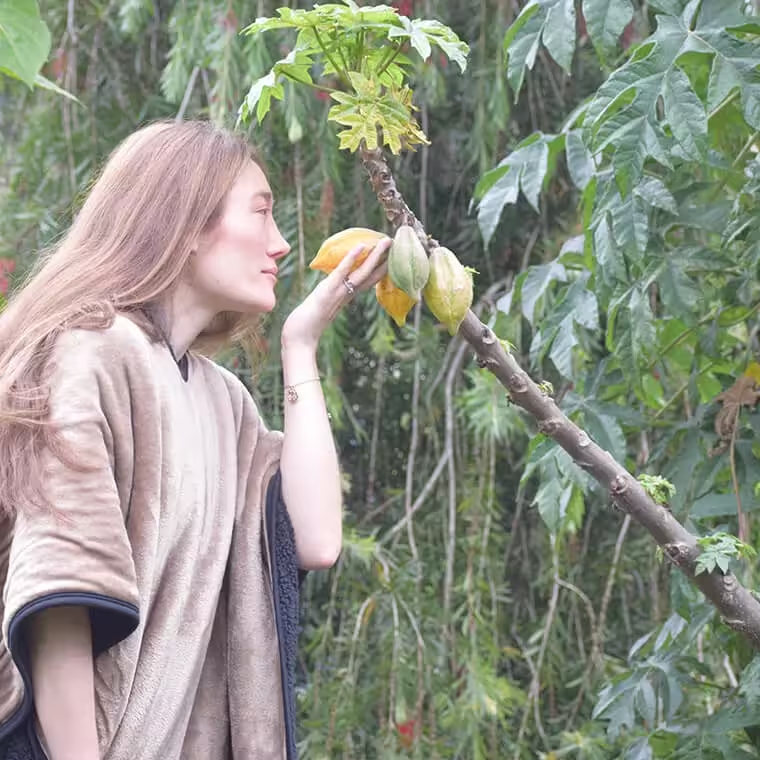
One of the plans you can enjoy when staying at our hotel is a relaxing walk along trails lined with native plants of Cundinamarca.
As you move along these paths, you’ll notice how scents and colors change with the time of day and the season.
In some stretches, discreet flowers keep you company; in others, glossy leaves announce the arrival of birds and butterflies.
Before we go on, it’s worth answering a frequent question: what does it mean for a plant to be native, and why does it matter?
That answer will help you better understand the landscape around you.
If you’re someone who cares for our planet, keep reading to discover 10 native plants of Cundinamarca and their importance in our local ecosystem.
What does it mean for a plant to be native?
A native species is one that naturally belongs to a region or ecosystem, whose presence is explained by ecological processes rather than recent human introduction.
In Colombia, institutions such as the Instituto Humboldt and urban restoration texts use this definition to promote responsible planting with flora that is truly part of the country.
The term is also used for crops originating in other parts of the American tropics that have been used in Colombia since ancestral times.
Which tree species are native to Cundinamarca?
Among the most recognizable in Andean and cloud forests are the Andean oak (Quercus humboldtii), encenillo (Weinmannia tomentosa), arrayán (Myrcianthes leucoxyla), and pino romerón (Retrophyllum rospigliosii).
Why are native plants important?
Native plants play a key role in maintaining ecosystem balance. They’re vital for protecting water sources, improving soil health, and helping regulate local climate.
For years, many of us in the Ubaté Valley have been reforesting our landscape with native plants.
At our hotel, we’ve focused on preserving these species and replacing invasive ones with native trees.
Below we share useful notes on 10 native plants of Cundinamarca—for gardening lovers and landscape enthusiasts alike.
1. Cajeto (Citharexylum subflavescens)

A sun-loving verbenaceous tree that can reach 15–20 m when mature, with white flowers and very visible red fruits.
It prefers well-drained soils, sunny exposures, and a deep planting hole enriched with organic matter; on slopes, mulching helps retain moisture.
Where it grows: 1,100–2,800 m a.s.l.; present in Cundinamarca and other Andean departments. Family: Verbenaceae.
Traits: Temperate–cool climate tree; also known as “palo de guitarra” for its timber.
Planting & care
- Light: Full sun or bright light, typical of open Andean slopes.
- Soil: Well-drained; avoid waterlogging.
- Propagation: Fresh seed; protect seedlings from cold winds.
Landscape use: Great for avenues and borders; attracts local fauna.
Why add it to your garden: A distinctly Andean species that adds identity to any collection of native plants of Cundinamarca.
2. Pino romerón (Retrophyllum rospigliosii)
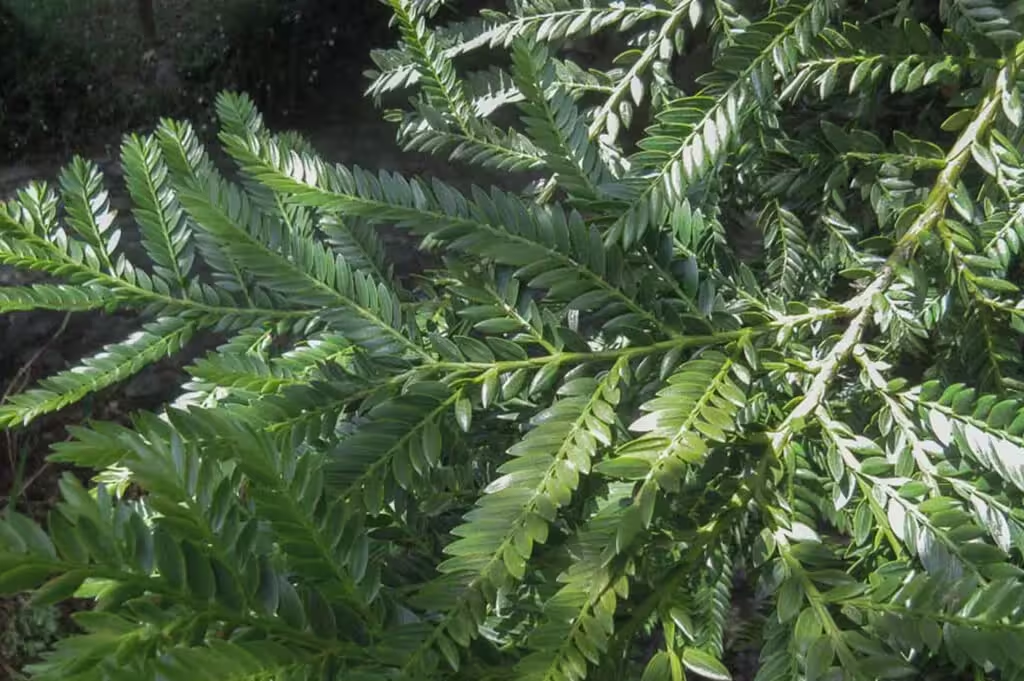
This Andean cloud-forest conifer adds vertical structure and helps regulate the microclimate on slopes.
It needs space (deep roots, wide crown). Plant it in well-drained soils where it can receive strong morning sun.
The pino romerón is listed as Vulnerable by the International Union for Conservation of Nature (IUCN), meaning it faces a high risk of extinction in the wild.
Responsible planting, connecting forest patches, supports its conservation.
Where it grows: Montane and cloud forests, 1,500–3,750 m.
Traits: Large tree (up to 45 m); valued timber; historically present in high-Andean pine stands.
Planting & care
- Light: Full sun at elevation; tolerant of mist.
- Soil: Deep, well-drained, ideally rich in organic matter.
- Spacing: Broad crown—keep at least 6 m from buildings.
- Conservation notes: Encourage in situ planting on rural land to recover Andean cover.
- Ecological value: Pino romerón forests support birds and help regulate water on slopes.
3. Arrayán (Myrcianthes leucoxyla)
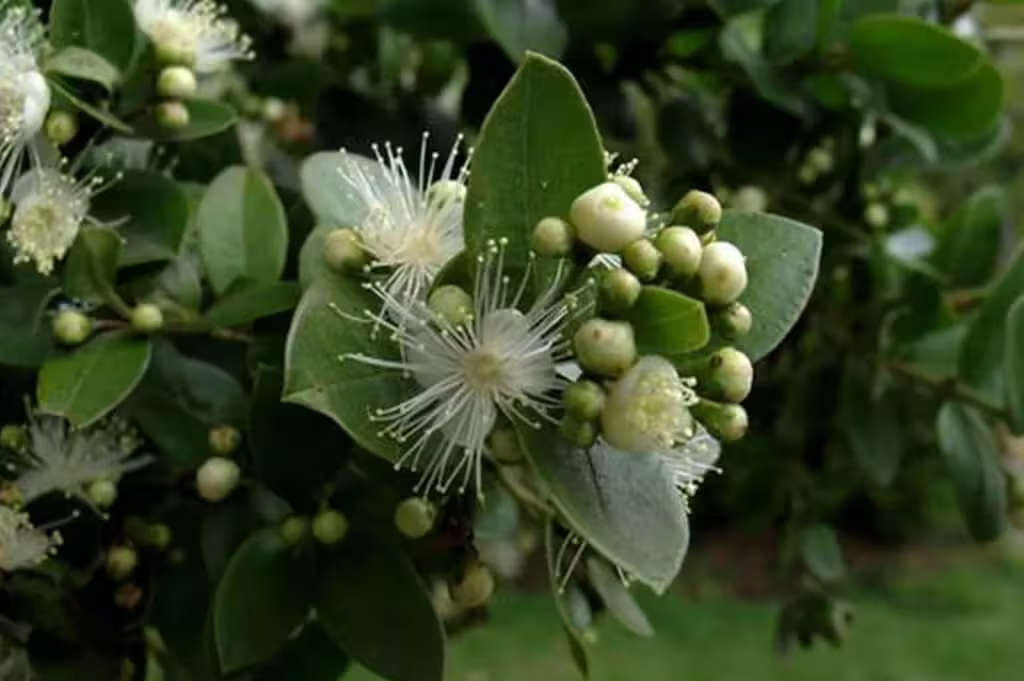
The citrusy scent of its leaves and its pale bark are unmistakable on morning walks. It shines in sunny hedgerows or beds and is ideal for high-elevation gardens.
Seeds may take time to germinate (as with many myrtles).
Where it grows: 2,650–3,200 m; typical of cold climates in Boyacá and Cundinamarca. Family: Myrtaceae.
Traits: Pale bark, aromatic leaves; tolerates light frost.
Planting & care
- Light: Bright sun to partial sun.
- Soil: Loam to sandy loam; drainage is essential.
Uses: Hedgerows and woodland beds.
4. Hayuelo (Dodonaea viscosa)
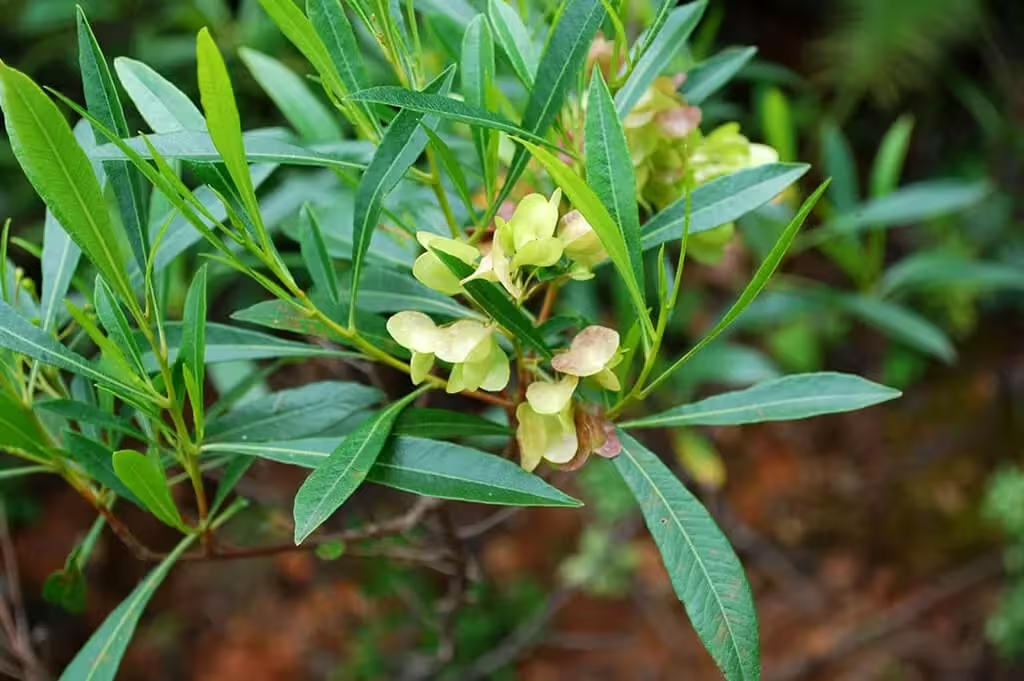
The “all-terrain” shrub for dry edges: hardy, fast to establish, excellent for erosion control and windbreak hedges.
Give it full sun, well-drained soils, and moderate watering during establishment so it later tolerates dry spells. Its winged fruits are a nod to the mountain winds.
Where it grows: 2,200–2,900 m; very common in Cundinamarca. Family: Sapindaceae.
Traits: Narrow leaves; tolerates drought and poor soils; attracts birds and insects.
Planting & care
- Light: Full sun.
- Soil: Poor to medium, always well-drained.
- Propagation: Seed; a survivor for slopes and erosion control.
5. Mortiño / Agraz (Vaccinium spp.)

On cool afternoons, mortiño/agraz shrubs stand out with purple berries rich in anthocyanins.
In Colombia, two scientific names are common: Vaccinium meridionale (agraz) and V. floribundum (mortiño), both Andean and native.
To help them thrive, mimic encenillo understory: acidic substrate rich in leaf litter, steady moisture without waterlogging, and filtered light.
They’re perfect for edible borders, attract pollinators, and add a local culinary story (jams, sauces) that fits our hotel experience.
Traits: Shrub 1.5–7 m; fruits with high antioxidant potential.
Planting & care
- Light: Bright sun to partial shade.
- Soil: Acidic, organic (like encenillo understory); avoid lime.
- Watering: Moderate and consistent without puddling.
Use: Edible and pollinator-friendly hedges for mountain gardens
Where it grows: 2,200–2,900 m; very common in Cundinamarca. Family: Sapindaceae.
Traits: Narrow leaves; tolerates drought and poor soils; attracts birds and insects.
Planting & care
- Light: Full sun.
- Soil: Poor to medium, always well-drained.
- Propagation: Seed; a survivor for slopes and erosion control.
6. Espino garbanzo (Duranta mutisii)

A vigorous, spiny, highly melliferous shrub; its bluish-white flowers hum with bees by mid-morning and its fruits resemble tiny chickpeas.
Use it as a defensive hedge and bird refuge along sunny boundaries. It propagates by seed or semi-hardwood cuttings.
In loamy soils with establishment watering, it forms dense masses that provide privacy while keeping a natural look.
Where it grows: Northern Andes; native, Verbenaceae. In Bogotá it’s described with chickpea-like fruits.
Traits: Arched branches, tubular bluish-white flowers; very attractive to pollinators.
Planting & care
- Light: Full sun.
- Soil: Loam; tolerates moderate drought.
- Propagation: Seed or semi-hardwood cuttings.
Use: Defensive hedges and wildlife shelter along rural edges.
7. Cucharo (Myrsine guianensis)

Cucharo has the understated elegance of woodland edges: leathery leaves, bird-feeding fruits, and a silhouette that frames trails.
In cold climates it can exceed 10 m, so place it where it won’t block views. Plant in moist but well-drained soils with bright light or partial shade.
As a transition tree between garden and forest, it enriches paths and walkways.
Where it grows: Widespread in Colombia; frequent on the Bogotá Savanna and the Eastern Hills.
Traits: Small tree (about 10–20 m); leathery leaves; clusters of fruits that feed birds.
Planting & care
- Light: Bright sun or partial shade (forest edge).
- Soil: Sandy-loam, moist yet well-drained.
- Propagation: Seed; protect seedlings from harsh midday sun.
8. Chicalá (Tecoma stans)
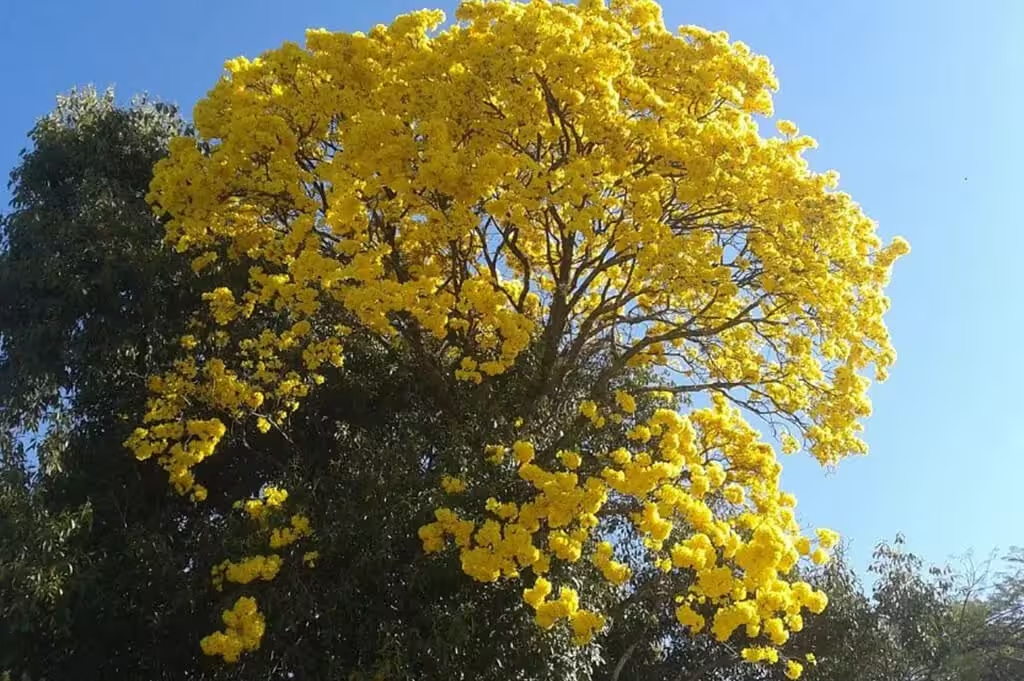
When the garden needs a burst of color, chicalá answers with clusters of bright yellow flowers that attract bees and hummingbirds.
It loves sun, is resilient, and germinates easily from winged seeds; it appreciates rocky or loamy, well-drained soils. It’s great for slopes or as a luminous accent near seating areas.
Where it grows: From the southern U.S. to northern Argentina; native to the Americas and common in Colombia’s temperate climates.
Traits: Abundant yellow flowering; tolerates drought and poor soils.
Planting & care
- Light: Full sun.
- Soil: Well-drained, even rocky.
- Propagation: Winged seeds; easy to germinate.
Use: Color for patios and slopes; a magnet for bees and hummingbirds.
9. Garrocho (Viburnum spp., incl. V. triphyllum / V. tinoides)

In the high-andean forest, garrocho frames clearings with white inflorescences and wine-colored drupes that feed birds.
It prefers soils rich in leaf litter, with steady moisture and good drainage. In cold-climate gardens it works well as a backdrop for shaded paths.
It can take on a shrub or small-tree form. Mulching helps retain root moisture.
Where it grows: 2,400–3,200 m; recorded in Cundinamarca under local names such as chuque/chucua/garrocho; Adoxaceae.
Traits: White inflorescences and wine-colored fruits; characteristic of high-andean forest.
Planting & care
- Light: Forest edge (filtered sun).
- Soil: Moist, rich in leaf litter, well-drained.
- Propagation: Seed; slow growth.
10. Dwarf “alcaparro” (Senna multiglandulosa)
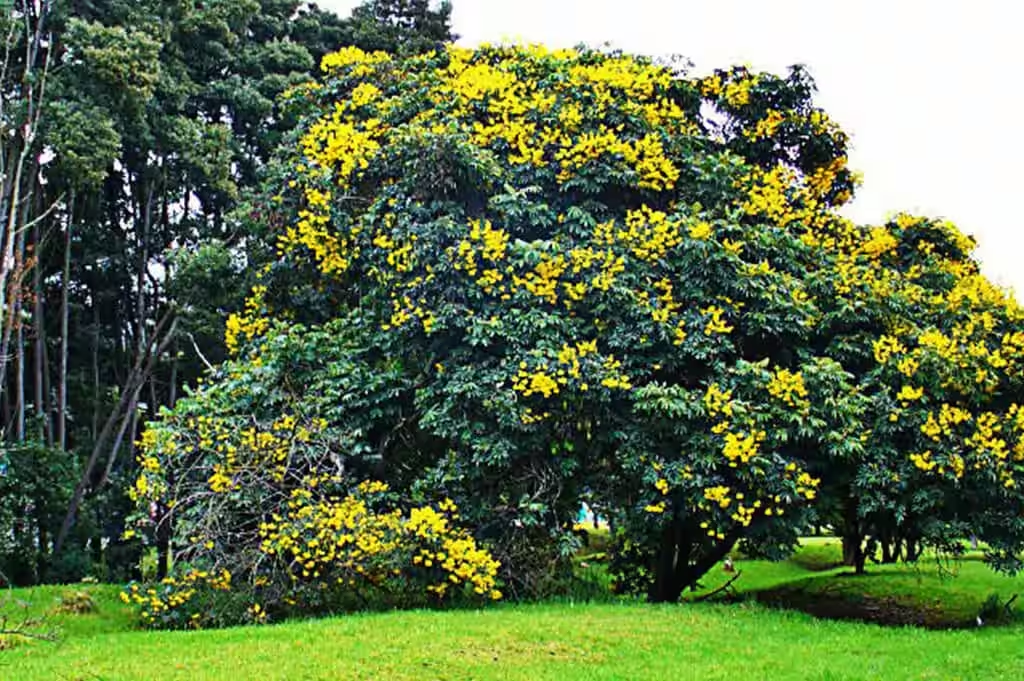
Widely used on the Bogotá Savanna for its yellow blooms and compact habit (2–3 m). Ideal for sunny edges and loamy or sandy soils with minimal waterlogging.
Where it grows: Leguminous shrub cultivated and widely used on the Bogotá Savanna; local records list it as “alcaparrito,” 2–3 m tall.
Traits: Abundant yellow flowers; ornamental and melliferous; great for high-elevation gardens.
Planting & care
- Light: Full sun.
- Soil: Loam to sandy; low compaction.
- Propagation: Seed (pre-germination with light scarification).
Native plants of Cundinamarca are more than names on a list—they’re pieces of a living landscape.
You’ll find some of them along our trails, turning your walk into a quiet, authentic, deeply Andean experience.



